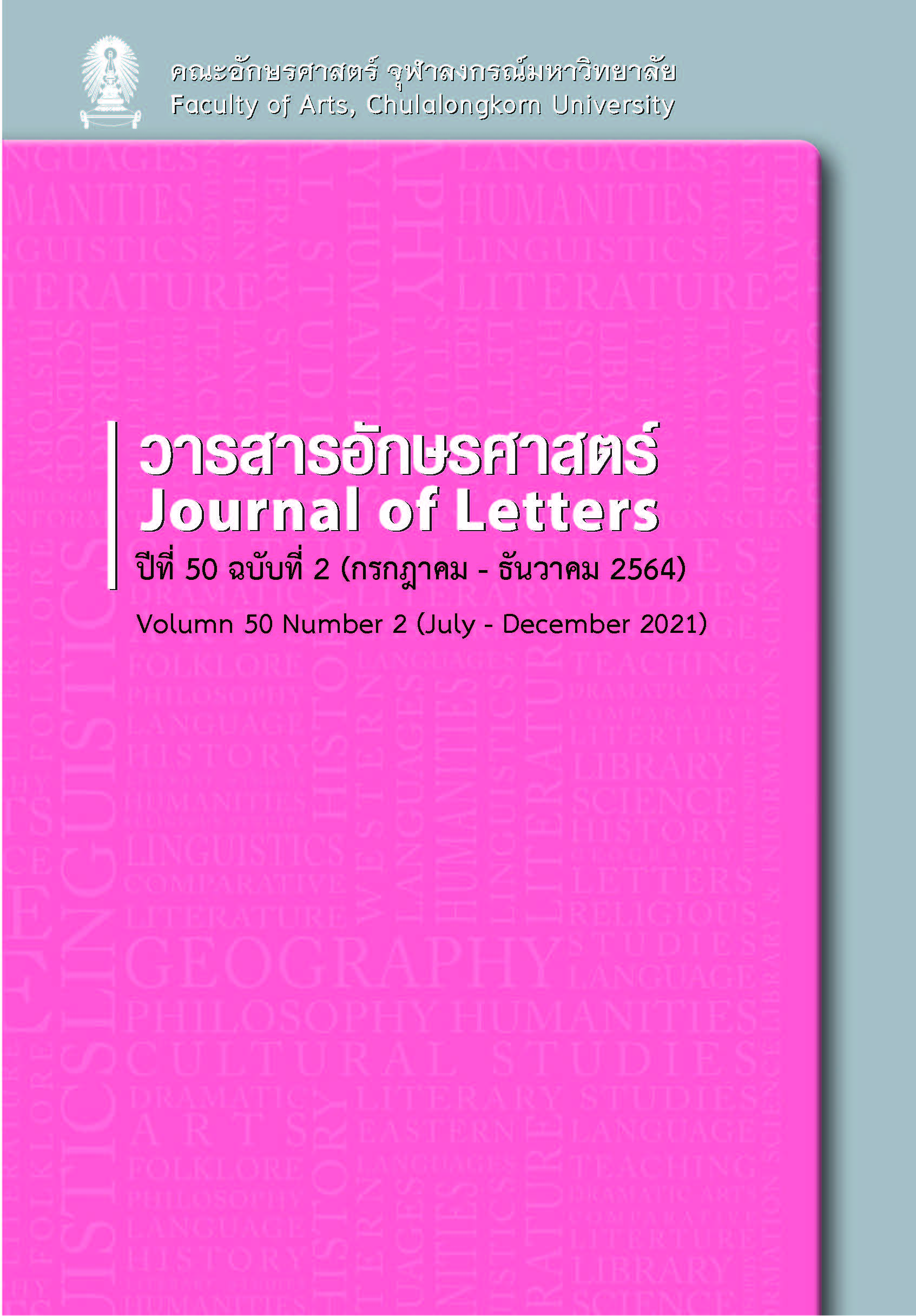Assessing Scholarly Debates on the Significance of the Deity Xiwangmu in Han Dynasty Tomb Art
คำสำคัญ:
Xiwangmu, Chinese art history, Han dynasty, Chinese archaeology, Chinese religionบทคัดย่อ
This paper discusses differing representations of Xiwangmu in Han art and texts. While these representations share some characteristics that indicate the same deity, Han artists’ created a wide variety pictures of Xiwangmu in tomb murals. Many leading scholars have produced excellent pieces of scholarship regarding Xiwangmu as depicted in Han art. The Han period was a significant time for the transformation of Xiwangmu. Various descriptions of her were recorded in pre-Han texts, and she gradually became a deity representing yin during the Han dynasty. However, Han texts do not provide a clear explanation for this change. We believe that Han funerary art could offer evidence to fill this gap. Her images in tomb art are different in each area and each period. Scholars also interpret this archaeological evidence differently. Thus, the process of transformation may be difficult to unravel as there is no unified view concerning the image of Xiwangmu during the Han dynasty. We hope to offer insights regarding the evolution of Xiwangmu on the basis of scholarly debate.
เอกสารอ้างอิง
Academia Sinica Digital Resources. (n.d.). Xiaotangshan shici tang xibi huaxiang孝堂山石祠堂西壁畫象 [Xiaotangshan stone shrine’s west wall relief]. https://digiarch.sinica.edu.tw/digiarch_en/content/repository/resource_content.jsp?oid=1828608&queryType=qs&queryString=%E5%AD%9D%E5%A0%82%E5%B1%B1, accessed October 26, 2021.
Cahill, Suzanne E. 1993. Transcendence and Divine Passion: The Queen Mother of the West In Medieval China. Stanford, Calif.: Stanford University.
Chavannes, Édouard. 1913. Mission Archeologique dans la Chine Septentrionale (Vol. II). Paris: E. Leroux.
Chinese Text Project. (n.d.-a). Er Ya. https://ctext.org/er-ya/shi-di, accessed April 28, 2021.
Chinese Text Project. (n.d.-b). Huainanzi. https://ctext.org/huainanzi/lan-ming-xun, accessed October 28, 2021.
Chinese Text Project. (n.d.-c). Shan Hai Jing. https://ctext.org/shan-hai-jing/xi-shan-jing, accessed April 28, 2021.
Chinese Text Project. (n.d.-d). Shiji. https://ctext.org/shiji/tai-shi-gong-zi-xu, accessed April 28, 2021.
Chinese Text Project. (n.d.-e). Zhuangzi. https://ctext.org/zhuangzi/great-and-most-honoured-Master, accessed April 28, 2021.
Fracasso, Riccardo. 1988. Holy Mothers of Ancient China: A New Approach to the Hsi-wang-mu 西王母 Problem. T'oung Pao, Second Series, 74(1/3): 1-46.
Gao, Wen 高文 (Ed.). 1987. Sichuan handai huaxiang shi 四川漢代畫像石 [The stone reliefs of the Han Dynasty in Sichuan]. Chengdu: Ba Shu shushe.
Goldin, Paul R. 2001. The Motif of the Woman in the Doorway and Related Imagery in Traditional Chinese Funerary Art. Journal of the American Oriental Society 121(4): 539-548.
Goldin, Paul R. 2002. On the Meaning of the Name Xi wangmu, Spirit-Mother of the West. Journal of the American Oriental Society 122(1): 83-85.
Gong, Tingwan龔廷萬 (Ed.). 1998. Ba Shu Han dai huaxiang ji巴蜀漢代畫像集 [Pictorial Han Art from Ba and Shu]. Beijing: Wenwu.
Graham, A. C. 1989. The Inner Chapters. London: Unwin Paperbacks.
Harvard University, Fine Arts Library. 1900-2000. Chinese Rubbings Collection.
https://id.lib.harvard.edu/curiosity/chinese-rubbings-collection/6-W271394_urn-3:FHCL:904239, accessed October 26, 2021.
Huang, Minglan 黃明蘭. 1977. Luoyang xihan Bu Qianqiu bihua mu fajue jianbao 洛陽西漢卜千秋壁畫墓發掘簡報 [Excavations of the Western Han tomb of Bu Qianqiu with Wall Paintings at Luoyang]. Wenwu 文物 [Cultural Relics] 1997(6): 1-12.
Irwin, Lee. 1990. Divinity and Salvation: The Great Goddesses of China. Asian Folklore Studies 49(1): 53-68.
James, Jean M. 1988. The Iconographic Program of the Wu Family Offering Shrines (AD 151-ca. 170). Artibus Asiae 49(1/2): 39-72.
James, Jean M. 1995. An Iconographic Study of Xiwangmu during the Han Dynasty. Artibus Asiae, 55(1/2): 17-41.
Karlgren, Bernhard. 1931. The Early History of the Chou Li and Tso Chuan Texts. Bulletin of the Museum of Far Eastern Antiquities 3: 1-59.
Karlgren, Bernhard. 1946. Legends and cults in ancient China. Bulletin of the Museum of Far Eastern Antiquities 18: 199-365.
Kern, Martin. 2017. Language and the Ideology of Kingship in the “Canon of Yao”. In Origins of Chinese political philosophy: studies in the composition and thought of the Shangshu (Classic of Documents), Martin Kern, and Dirk Meyer, eds., 23–61. Leiden: Brill.
Kohn, Livia. 1998. Yin and Yang: The Natural Dimension of Evil. In Philosophies of Nature: The Human Dimension, Robert S. Cohen, and Alfred I. Tauber, eds., 91-105. Dordrecht: Springer Netherlands.
Liu, An. 2010. The Huainanzi: A Guide to the Theory and Practice of Government in Early Han China (John S. M., Trans; Ed.). New York: Columbia University Press.
Loewe, Michael. 1979. Ways to paradise: the Chinese quest for immortality. London: Allen & Unwin.
Philology Hall 小學堂. 2021. Jiaguwen 甲骨文 [Oracle Bone Script]. https://xiaoxue.iis.sinica.edu.tw/jiaguwen, accessed November 8, 2021.
Suhadolnik, Nataša V. 2011. Han Mural Tombs: Reflection of Correlative Cosmology through Mural Paintings. Asian Studies 15(1): 19-48.
Tseng, Lanying. 2012. Funerary spatiality: Wang Hui's sarcophagus in Han China. Anthropology and Aesthetics 61-62: 116-131.
Wang, Shumin 王叔岷. 1994. Zhuangzi jiaoquan莊子校詮 [Zhuangzi with commentaries]. Taibei: Zhongyan Yanjiuyuan Lishi Yuyan Yanjiusuo.
Wu, Hung. 1987. Xiwangmu, the Queen Mother of the West. Orientations 18(4): 24-33.
Wu, Hung. 1995. Monumentality in Early Chinese Art and Architecture. Stanford: Stanford University Press.
Xin, Lixiang 信立祥. 2000. Handai huaxiangshi zonghe yanjiu 漢代畫像石綜合研究 [A Comprehensive Study of Han Pictorial Stones]. Beijing: Wenwu chuban she.
Zhao, Chengfu 趙成甫. 1990. Xin ye fan ji han hua xiang zhuan mu 新野樊集漢畫像磚墓 [Pictorial Brick Tombs of the Han Dynasty at Fanji, Xinye, Henan]. Kaogu xuebao考古學報 [Acta Archaeological Sinica] 1990(4): 475-509.
ดาวน์โหลด
เผยแพร่แล้ว
รูปแบบการอ้างอิง
ฉบับ
ประเภทบทความ
สัญญาอนุญาต
การป้องกันปัญหาด้านลิขสิทธิ์และการคัดลอกผลงาน
ผู้เขียนบทความมีหน้าที่ในการขออนุญาตใช้วัสดุที่มีลิขสิทธิ์คุ้มครองจากเจ้าของลิขสิทธิ์ ผู้เขียนบทความมีความรับผิดชอบที่จะต้องปฏิบัติตามกฎหมายในการคัดลอกและทำสำเนาวัสดุที่มีลิขสิทธิ์อย่างเคร่งครัด การคัดลอกข้อความและการกล่าวพาดพิงถึงเนื้อหาจากวัสดุตีพิมพ์อื่น ต้องมีการอ้างอิงแหล่งที่มากำกับและระบุแหล่งที่มาให้ชัดเจนในส่วนบรรณานุกรม การคัดลอกข้อความหรือเนื้อหาจากแหล่งอื่นโดยไม่มีการอ้างอิงถือเป็นการละเมิดจริยธรรมทางวิชาการที่ร้ายแรง และเข้าข่ายการละเมิดลิขสิทธิ์ตามพระราชบัญญัติลิขสิทธิ์ พ.ศ. 2537 หากมีการฟ้องร้องดำเนินคดีใด ๆ เกิดขึ้น ผู้เขียนบทความมีความรับผิดชอบทางกฎหมายแต่เพียงผู้เดียว



